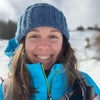Speed Hikers Are Missing the Point (and So Much More)
Hiking is about living in the moment, not speed.
Heading out the door? Read this article on the new Outside+ app available now on iOS devices for members! Download the app.
As new Fastest Known Time (FKT) thru-hike attempts fill outdoorsy newsfeeds, I think it’s time for an oppositional opinion: Hiking should only be a speed sport if you’re getting chased by a bear.
In the last decade, the attention given to FKTs on long trails has grown, along with the number of attempts. And with the introduction of local records and spread of social speed-ranking apps like Strava, even casual hikers are getting in on the craze. Successful record-setters become elite hikers, the best of the best—what incredible fitness and discipline! Look how well they hiked that dang trail! They went so light they didn’t even bring a stove and survived a week on GU packets and dry ramen!
These are incredible physical achievements, certainly. But they aren’t better than any “normal” hike. In fact, they miss the point altogether.
Like many of us, I’ve had some long days on trail, speeding out the last dozen or more miles to make a shuttle or a college class. When I think back on them, though, I don’t remember a beautiful day of hiking, or even any of the scenery; I remember being tired and sore and ready to go home. That’s not the kind of hiking experience I want. I hike to enjoy time in the wilderness, to get away from the daily grind and live in the moment, not to get in and out as fast as possible. Some of my favorite days of hiking covered only a few miles, moving at a speed that any FKTer would find laughable.
On an untimed hike, I stop every few minutes to take a photo, I get distracted by interesting rocks, I pull a cloudspotting guide out of my backpack and don’t move on until I’ve recorded a stack of lenticular clouds and a school of budding cumulus (see Level Up on page 32 for a crash course on cloud types). I even—horror of horrors—take a leisurely lunch, sitting with the sound of the wind and the sight and scent of sage and ponderosa pines long past the last bite of my sandwich.
But you know what? I’ll remember those hikes forever. Fast-moving, high-mileage days remain a blur of frantic watch-checking, but I can draw on the memories of my slow hikes for inspiration even years later. FKTs are a nice accolade, but what’s the point of hiking the PCT, AT, or any of the smaller trails in between when you barely see or appreciate the High Sierra or San Juan Mountains? How are you supposed to learn anything but the best techniques for speed-hiking if you don’t take the time to experience the flora, wildlife, and history of the places you’re hiking? It’s a personal journey, a quest, not a race. The lessons of the wilderness aren’t found in ultralight gear and record split times; they’re in the stillness you have to pay attention to find, in the wildlife that will resume its daily habits around you if you just sit quietly for long enough.
Plenty of people find value in FKTs, pushing themselves to their mental and physical limits. You can learn a lot from a tough experience like that, and for some hikers, pushing speed limits is how they grow. Others race through FKTs as fundraisers, putting themselves through grueling trail days in the name of a larger cause. That may not be for me, but everyone hikes differently, and we can all share the trail.
So go ahead and set your watches and strap on your hydration vests; I won’t stop you. Hike your own hike, as they say. If you need me, I’ll be the hiker barefoot in the creek on a long snack break, enjoying every single moment of my day.
